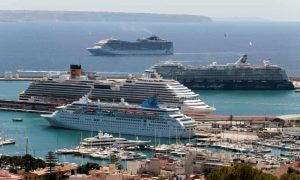Spanish officials hail ‘historic’ deal to limit arrivals to maximum of three vessels a day at Mallorca port
 Palma port in Mallorca, Spain, is among the busiest cruise ports in the Mediterranean.Photograph: Enrique Calvo/Reuters
Palma port in Mallorca, Spain, is among the busiest cruise ports in the Mediterranean.Photograph: Enrique Calvo/ReutersOfficials in the Balearic Islands will seek to limit cruise ships to a maximum of three vessels a day at its largest port, in a deal described as the first of its kind in Spain.
The regional government said in a statement that arrivals at Palma in Mallorca would be limited when possible to three cruise ships a day, one of the vessels allowed to be a mega-cruise liner carrying more than 5,000 people, starting in 2022.
Calling the deal historic, officials estimated it would result in a 13% drop in arrivals at one of the busiest cruise ports in the Mediterranean compared with 2019.
The procession of cruise ships passing through Palma has been a source of friction for years, pitting environmental concerns against the economic benefits of a sector in which as many as eight ships arrive on the same day,disgorging more than 22,000 people into the maze of narrow streets in Palma’s old town.
In 2019, when more than 2.6 million cruise-ship tourists visited the Balearic Islands, more than 25 organisations joined forces to call for the vessels to be limited to one arrival a day with a maximum of 4,000 tourists.
“The mega-cruise ship tourism arriving in Palma has grown in a way that is unsustainable and undesirable for our city, leading to serious environmental impact and increasing social protest,” they said in a joint manifesto.
“Tourist overcrowding devalues our historical and cultural heritage, converting urban space into a theme park for visitors only and degrading the tourist experience for others.”
The regional government said the deal had been more than two years in the making.
“It means setting, for the first time, a real limit to the arrival of cruise ship passengers to Palma, something that would not have been possible without the will of the sector,” Iago Negueruela, the regional official in charge of economy and tourism, said.
Similar deals have been struck for Dubrovnik in Croatia and Aalborg in Denmark, Negueruela told the Spanish newspaper El País. “We’re the first to do so in a port as large as Palma.”
As cruise ship arrivals were often scheduled months in advance, the new daily limits would include fewer than 20 exemption days in order to honour previously signed contracts, the government said. On these days the limit for cruise ship arrivals would be increased to four, though the number of total passengers would be capped at 59,500 a week.
The five-year deal was criticised by critics and proponents of cruise ship tourism. Some, such as the Platform Against MegaCruises, said little would seemingly change.
“Three cruise ships a day – one of them with a capacity of more than 5,000 passengers – still seems to us a very high figure for what the city can bear,” it said. “The regional government has missed out on the opportunity to make a courageous decision to safeguard residents of the Balearic Islands, their environment, their health and their right to the city.”
The competing platform Yes to Cruises described the push to limit the sector as an “error” that could have grave repercussions for an economy, after a 2015 study by the port authority estimated that tourism linked to cruises supported more than 5,500 jobs and contributed €256m in direct and indirect revenues to the region.
The spokesperson for the platform, the local tour guide Álex Fraile, suggested this would set a precedent: “Is the next step to restrict the arrival of aircraft at [Mallorca’s] Son Sant Joan airport?” .

Leave A Comment